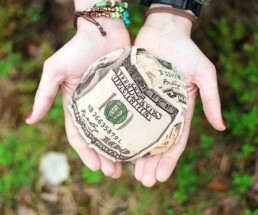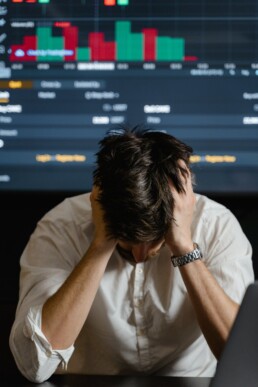Growth vs Value Investing
In the article “what is a stock”, we mentioned growth stocks and value stocks. This differentiation applies to two different approaches to allocate money in the market, even creating two competing schools of thought.
When we talk about growth, we are defining a quick, fast, nervous growth approach, popular in today's start-ups such as Uber, Tesla, and all the other New Economy companies.
The value approach, in contrast, is based on slow steady growth. More on a kind of Warren Buffet vision.
These two approaches, so different from each other, can obviously be divided into different strategies or be mixed in the average investor's portfolio. The important thing is to grow our capital.
We can define the investor's most suitable approach based on 3 characteristics:
1 the growth of the company underlying the stock.
In this case, our focus will be directed at the company's economic growth and returns. This is a Growth approach when these characteristics outperform other companies in the same market or beat the market itself. It is the obsessive search for the new Apple to revolutionize the industry.
Investors look for companies with a couple of years of rapid growth, and these companies will in most cases be smaller and younger and leaner than their competitors.
In contrast, Value investors are not interested in these mirabulous performances but aim for more mature and stable companies with slower growths.
2 Valuing the 'stock
To be a value investor is to be a bargain hunter, buying low for stocks of higher intrinsic value than the market now prices. In the mindset of the value investor, you don't buy stocks just because they are cheap but because there is a study and a search for value behind them.
Growth stocks tend to be much more expensive, but the 'investor will be pay this price because he expects exponential upside.
3 price volatility
growth stocks in most cases suffer from higher volatility than value stocks. This is because Growth stocks have a higher inherent risk given the fundamentals of start-up companies that are not yet established.
the growth approach is a riskier approach, although it may be the one that pays the most if you are buying a company that will have exponential growth over the years
growth stocks are usually sold and bought based on promises. Promises of growth, turnover, and market position. But promises are not always kept.
the value approach is more time-consuming and much more boring, with low volatility and little market excitement.
what is the best approach? depends on the period you are considering, how much risk you are willing to expose yourself to, and what kind of companies you are analyzing. A mix of the two methods might be the right choice, while a single growth approach in a specific sector that is growing is risky but in principle profitable. Hopefully.
IPO
If a company needs money, one way to avoid getting bogged down by going into debt, or further debt, is to become a Public Company or to going public offering shares of the company on the market.
These operations are called IPOs or initial public offering.
It is not exactly a very simple thing and indeed there are a lot of bureaucratic steps and tons of paperwork to fill out, however, for popular sentiment an IPO is a demonstration of business and also personal success on the part of the owner.
Let's go through an example on how to list on the U.S. market.
Step 1- Investment Banker
Investment Bankers are an individual or group of individuals, whom we can refer to for convenience as "early investors," who help the company informally raise initial capital. The goal is to recover as much capital as possible, with the banker doing all that follows to promote the IPO.
Step 2-documentation
A registration document with the SEC commission will then have to be drawn up.
this document will be devoted to all the details of the company's operation, to explain in detail the company's operations, management and its financing prior to the IPO transaction. An identity card will then have to be created for the financial authorities.
the SEC will obviously investigate to see whether there is true or false information in the document, only designed to defraud the public. The SEC must also understand whether the listing is feasible based on the financial stability of the Company, to protect investors.
If all goes well, a listing date is decided.
Step 3 - create a document for the public
the banker, after approval by the SEC, should create a document for the public with a description of the company, with its operations, current performance, and on projected future operations.
the document will be circulated into investment institutions and larger investors. This is just to begin to create interest
This does create the so-called indication of interest, to see how many stocks people are willing to buy and at what price
This is to make sure that the selling price of the stock is well calibrated when they are listed on the market, this also makes the allocation of the shares defined, that is, how many are sold
IPOs also suffer from the hype of the moment. Our company may be on the top level and be particularly fashionable, this will be reflected in its listing price. A big ask might be a problem for the average investor, and too high a price might not be a sensible purchase.
On the contrary, an IPO of a company that receives lukewarm or no feedback may also be postponed precisely because the forecast for market collection is really unsatisfactory.
IPOs, like any financial transaction, have inherent risks for the average investor. They need to be well researched and understood, especially if it makes sense to jump in at a moment of hype.
What is a currency?
Dollars, euros, pounds, marks, lire, sesterces and florins
Coins and their names have always been synonymous of wealth. But what is currency?
Today when we talk about currency, we think about the 10 dollars bill, but many of us think of ATM and credit cards. But currency is the fuel of every modern economy and is the unit of measure for the production of goods and services.
To understand the economic value of a good or service we use Currency as the unit of measure to make comparisons between different assets. We must then remember that broadly speaking when we have too much currency we suffer the phenomenon of 'inflation while when we have too little currency we suffer deflation. In theory.
It should be remembered that today's currency is issued by central banks against the transfer of collateral i.e. government bonds, so this currency is borrowed or rather created as loan, which generates debt.
Thousands of years ago, before the invention of currency, the 'economy was based on barter, which, however, was not an efficient system given the various things to be bartered. If I own 3 eggs and I need a cow for my farm, well barter becomes a system that makes at least one party interested in the exchange unhappy. The exchange becomes impossible and I will never get the cow I need. And the eggs rot.
Now given the impossibility of applying the system all exchanges, what we call "currency" was invented to solve every problem. With X number of coins I can go to my friend and get the cow I am interested in, so the same coins can be used by my friend to pay the worker to fix his farm that is falling apart.
Coins also, in 'antiquity but also until recently, had an intrinsic value determined by the value of gold and silver used for minting.
Coins, however, are a difficult commodity to carry around in large quantities; they can be stolen or lost. Buying a loaf of bread or a palace, requires a large difference in the quantity of coins. To overcome these problems, checks were born, which later turned into today's banknotes.
We have condensed the story as much as possible for ease of understanding.
Each banknote guaranteed the existence of its gold value at the issuer's depository.
in 1944, at the height of World War II, the monetary system was changed at Bretton Woods, and the only currency convertible into gold becomes the U.S. dollar with all other currencies pegged to it
in 1971 nixon abandoned gold convertibility for the dollar to avoid default because US was involved in the Vietnam War. On that day the fiat currency was born, or perhaps it would be better to say returned to the stage of history, whose value is given by trust in the 'authority that imposes its use, thus the government that issues it.
there are no more limits in the creation of money, being able to print as much currency as one wants and needs since the currency is created by the central bank of a country, in this case if we are talking about Europe , by the ECB.
In the history of our planet and of our civilization, kings, sovereigns and emperors had the ability to create the currency, and then this ability moved on to lordships and governments , and now end up with central banks that are private entities.
To date, the value of the currency is given by the international exchanges that take place between the various states, which implies considering the strength of the various economies as well.An increase in the value of a country's currency will make the purchase of its goods and services abroad, by a foreign citizen with lower value currency more difficult. The higher the value of the currency, the higher the price of goods that will be exported. One of the unfair activities you can do is to artificially keep the value of your currency low to increase exports by going to devalue it. And yes I am talking about you, China!
This is where Bitcoin comes in, which is a "currency" that we can describe as special. In fact, nothing like it has ever been created in the history of 'man, while the economic history books are full of fiat currency experiments that failed. Go look at what happened a few decades before the French Revolution....
In fact bitcoin possesses two characteristics that are unique compared to fiat currency, namely its decentralization and its deflationary nature.
No one controls the protocol nor can anyone change its characteristics by issuing more or less coin than those decided in the protocol. The protocol can be modified but all users must agree to the modification.
In the long run, the deflative nature of bitcoin makes it an excellent tool for long-term savings.
Psychology, money and divorce
I was talking some time ago with a psychologist friend about how she was working more and more with couples or individuals who were going through the end of their marriage or were close to divorce. In the end, I realized that the main reasons that lead people to divorce are basically three and they are all issues related to Sex, Money, and Family. All issues that are mixed into a gigantic problem that destroys even the most loving couples.
Now I fully understand my friend's words and the situations she described. I cannot talk about family problems because every family is made differently, but money is the same for everyone. So is our reproductive system.
Managing the family budget is something delicate. Two people, with two different spending predispositions, come together wanting to start a family. These same people will have to profitably manage the money they themselves bring home.
The point is all about "managing profitably."
A person may be more predisposed to saving or to squandering. Going from the extreme of saving every penny to the other extreme of spending it all to the point of being left with bank account in deep red at the end of the month.
The issue of having a couple formed by the two extremes in the long run goes to create enormous tensions. As always, virtue lies in the middle, but the propensity to save is an innate quality and a behavior taught by parents.
In addition to how to spend money on everyday things, then go the choices and discussions for the long-term expenses that are considered important, namely house, car, and investments.
Things like changing the car every 2 or 3 years, looking for a beach house or deciding where to take the darn vacations.
Money is often an issue in every family, especially if one or more children are also involved. Making ends meet is crucial, as is ensuring an adequate amount in the children's future. If you want them to be educated in the right private school, you will need to have the right amount in the account.
Saving something is always important; making your wife or husband happy is equally so. But economic problems and the anxieties produced by these, in times of economic slowdown, become more and more acute. Anxieties and problems that are always reflected in the behavior of he or she in the family who administers and makes ends meet.
Think about it for a moment, if you are very worried about your economic situation, this worry will follow you everywhere, even during your quality time with your partner. Time that will no longer become quality time until it becomes nonexistent.
And after some time your partner will go looking for this quality time somewhere else. And you will end up being the second tier partner and usually end up breaking up.
Have you seen that loop? Money problems that become sex problems that become family problems. Complete destruction.
Of course, the description is overly simplistic. One cannot describe in totality the issues in a relationship and the various facets that each of us has that change behavior within a couple, but in broad strokes this example is a good picture of what happens.
What to do to avoid this?
When you have economic anxieties and issues, talk to your partner about it. He or she needs to be aware of the problem and understand why you are behaving a certain way. It may not be the easiest choice, but at least he will know that he needs to start cutting unnecessary expenses.
Explaining economic mistakes and errors is bad. Our egos will always suffer but heck, reality is reality and if you want to solve problems you must first accept that they exist. Dealing with problems and stress together can prevent 'misunderstandings and destructive or self-destructive behavior.
Having an emergency fund, large enough for a few months of survival, is always a good thing, and those who do not have it always take a risk that I find exaggerated.
A little available liquidity always makes sense. Especially now.
FOMO
FOMOOOOOOOOOOOOOOOO
What does this word mean?
Today we're going to explain a term that you surely read often, but that also has a deep meaning in the psychology of every trader.
FOMO means fear of missing out, and we could translate it as fear of having missed an opportunity, sometimes unrepeatable.
We can also see it as a social anxiety for having missed an interesting and very profitable investment train.
Fomo is one of the many biases working against you.
This feeling that you will feel deep inside will be a mixture of discouragement, anger towards yourself and frenzy to jump on the market without ifs and buts, without thinking and without having any regard to money management.
It's a feeling that is present especially now in the social media era, thank to the continuous updating of what other people are doing, the lifestyle that the social media of certain characters are selling us and their wealth.
You see on twitter and instagram unknown kids becoming millionaires overnight, driving around Dubai sitting in bentleys and surrounded by fabulous models, all accompanied by articles and pictures of their bank accounts at various zeroes.
And you're in your bedroom, in your underwear, guzzling a cola. It's obvious that you want to do what they do and have their lifestyle.
However, this emotion of envy you're feeling leads you to follow some advice that could be bad for your wallet.
Right now you're susceptible to those articles in blogs with titles like "the 5 coins you can't not have in your portfolio" or "XX's untameable growth" or "expected 200% return with YY".
To which we have to add all the messages that you read in the various chats, which promote things never heard that in most cases are scams.
And then you enter in the optics that "now or never" on some unknown coin, you buy it exaggerating and you throw away all your past gains.
You don't have to do that, it's not a competition and you don't have to buy things that in a normal situation you would have never bought.
And on top of that you are left with the anger of having thrown money away and you can only take it out on yourself.
This is why we talk so often about managing emotions and anxiety.
If you had stopped to think, none of this would have happened or you would have allocated a much smaller amount.
You've gone overboard with your level of risk
Now let's face it, social media are fake.
They are a mirror of what we would like to be and that we somehow make others see. But that we are not.
When we see these millionaire kids, their success is exaggerated to sell you one of their products.
Most of the successes of those we follow on social are exaggerated narratives.
The cars, jewelry and private planes are definitely rentals and the incredible models are only friends of their cousin or prostitutes.
None of these champions talk about their mistakes and losses but all they talk about are the victories and the fantastic billions they are making. Some even get paid to foment fomo or to sell scams or useless courses or useless books.
Now back to us, generally the rule to earn is buy low and sell high, which is very logical but in most cases if a stock is low, mentally evaluate the situation as negative, if it is high it is positive and you think it will go up again.
This is possible, but what if the uptrend is over?
If everyone is rushing to buy Ethereum after a 200 percent rise, you are compromising your risk level just because you are following the crowd, you are following the hype.
And the hype is the enemy
You're acting on the urgency to do something and that's not good because as you know deep down, returns are not guaranteed.
The fomo, the frenzy doesn't make you think rationally and doesn't deepen what you're putting your money on.
If you get caught up in the frenzy to buy after you've seen a post on some social, stop for a moment and think
who is making the post on social networks? Is he a serious and reliable person, is he an idiot?
Is he someone who knows something about it or is he a bum with no experience at all?
These questions can stop you from making some careless purchases.
And always remember that limited time windows in most cases hide nasty surprises.
I don't doubt that some of the axles being touted could be the new Tesla, but being cautious is always best.
You might feel like an idiot for missing an opportunity or will you be an idiot for losing all your money?
Keep calm and study.
5 steps to start investing
Getting started is not particularly difficult if you have a clear path in mind, otherwise you flounder left and right without doing anything, throwing your money away.
Investing needs to have specific goal in mind, whether it is to improve your economic situation or have funds to buy a house or to finance our business. We want to grow our capital so that we can then use it for ourselves.
Step n 1
Check your expenses and understand how you spend.
That is, where does the money go?
Understanding how you spend is the key to cutting unnecessary expenses and saving to start investing.
Let's see it this way, the money you will save will be the gasoline for your investments.
And your investments are like a car, without petrol you just stop and look around.
Now, after understanding how you spend, you have to choose how to allocate your budget.
Many suggest the 50 30 20 rule, which is 50% necessary expenses, 30 discretionary expenses and 20% savings.
You need to be disciplined but this also depends on what fixed expenses you have, such as a home or car loan.
Try to apply yourself on your personal sphere and your situation.
Step n2
Pay off debts.
Having a debt such as a mortgage or car payment is not a big problem, because they are debt that we can consider useful.
At the end of the mortgage you will have a house, we can call it a real estate value.
On the contrary, having a mortgage for an iphone or a television is not very smart.
Surely you can avoid spending that money on consumer electronics or other things that can be considered useless.
In fact, every debt has a cost, and you are paying for your iPhone more than what it costs in the store.
The costs of the debts you have on whatever you have bought must be checked, and if possible pay off these debts ASAP.
Remember we need gasoline for our car.
Step n3
Create an emergency fund.
It seems counterintuitive, cutting debt to have more money to spend on financial assets and then creating a fund with money that we shouldn't touch except in an emergency. Instead it makes sense, specifically for your psyche and for your safety.
In fact, you must be prepared to have fluctuations in your financial portfolio, with whatever asset you have formed it.
An emergency fund lets you know that in the event of any problem in your life, you can have a safety net to draw on.
Think about if you lose your job and don't find one for a few months. How could you live and pay the bills?
3 to 6 months of funds to live without work can be a good start for creating an emergency fund.
You can also make it grow over time, shifting some of your earnings.
The emergency fund will also allow you to have extra security when you go to invest.
Your psyche must be ready to handle the stress of financial positions.
Step n4
Understand if you can invest on your own or if you need help
In this case, you have to be honest with yourself.
Do you know what to do? Can you handle it psychologically?
Investing is not easy and burning an account is very easy.
Your psyche is risk averse and you need to learn to manage it.
Your risk tolerance may be higher or lower, but the pain for losses is real.
You have to understand how to manage anxiety and this leads you to wonder if you can do it alone or if you need a consultant.
If you believe you can do it yourself, then a long, very long course of study awaits you.
But it will enrich you and allow you to understand a lot of things about our world and our society.
Step n 5
Start today, with discipline.
The earlier you start, the better, because with the passing of age the attention decreases and because the longer you stay on the market, the greater your chances of earning.
Discipline requires you not to do things rashly, to remain balanced as investments and never, ever make the famous ALL INNN on the set-up that everyone is pushing during a Hype- Assett period.
Because you will know that it is the stupidest thing to do, especially when everyone is on FOMO.
Hype is the enemy.
The uncertainty of the investment
Today we are going to talk about the aspects behind investments and their psychology.
We are facing the uncertainty about investing in the financial world.
The human being is in the perennial search for security thanks to a natural genetic repulse to risk to make us survive.
Risk aversion in an environment where we can be killed by beasts or adverse climatic conditions is what allowed us to survive thousands of years ago.
Many people have an innate adversion to losses.
Try to think of losing 20 euros. In this case the pain will be greater than the pleasure of having earned the same 20 euros.
This means that these people are totally opposed to certain practices that allow them to increase their portfolio .
In fact, to have an interesting economic return you have to take risks, since risk is the fuel of the potential profit.
It is also true that some zero-risk investments still exist such as bank accounts but which yield practically are below zero.
And these are not at zero risk since there is the risk of bank failure.
Therefore, it is necessary to manage the investment risk.
In the financial world, risk means exposure to the possible loss of money, or the possibility that your investments will drop in value compared to the purchase cost.
The amount of risk we are willing to expose ourselves depends on various factors like volatility.
Volatility indicates an indecision on the price on the part of sellers and buyers, certainly equates to a greater risk that can be justified by the greater possible gain.
Precisely to maximize our earnings and to analyze the risk to which we are exposed, an analysis of possible events that could affect our investments must be made, a sort of exercise to manage some risks to which we may be exposed.
Among the risks that we can easily recognize are:
a rise or fall in interest rates by the central bank, affecting corporate loans;
a credit risk, with debtors unable to pay their obligations;
a sudden inflationary push in a specific country or worldwide;
A possible country risk, as happened with Greece or Argentina;
These last two risks can be placed in a large group that we can call
market risk or systematic risk.
This is a type of risk that can affect all companies operating in a specific country or market.
We are talking about a recession, which destroys all the spending power of the population or an environmental problem that jeopardizes a specific industry, such as a disease that attacks plants destroying them all over the world.
Going more into the details of a specific market we can then talk about the specific risk of a company, like Enron in the United States.
This type of risk refers to a specific company in a national or international market and can be caused by huge scandals, or by the appearance of new international competitors on the internal market or by a new legislative change that worsens our market situation.
Remember that every investment is under this kind of risk and that systematic risk is difficult to predict in the future while specific risk can be eliminated through diversification.
But then there are assets that are not subject to risk, those safe havens where everyone can take refuge.
Yes, they exist and generally the greatest exponent is gold.
However, it should be remembered that gold also has price fluctuations and that in the event of a crisis it could have a certain decline. But here we need to understand how much the drop is, for example if gold falls by 10% in a market that dives into minus 60 or 70% ...
Let's move on to another point of view, moving from investment to investor.
The psychology and preparation of those who put money into any investments are much more important than people think. It is necessary to understand the different risk tolerance of the different people who approach the market.
This tolerance is mainly given by two factors which are the predisposition to risk influenced by one's personality and personal financial culture, to which must be added the ability to manage emotions and the fear of losing one's money.
Managing anxiety and maintaining clarity to better manage the situation are two very important characteristics.
Think what could happen if we panicked at every slightest downtrend or wanted to take home every little profit.
Other factors that can make this situation worse, is your relative financial situation and in which time frame you are investing for your life. Maybe that descent won't change your life, but if you've used all your money on a single asset, it starts to be different.
Financial availability and your working salary are two factors that can make you feel better, combined with a long-term vision.
If we think of a personal safety net like a bank account with a good amount of money and a job with a good salary, a loss of 20% is something that we can expect. A short-term view means that risks and loss tolerance are approached differently.
The risks are generally in a short period of time, and the markets generally recover from the crisis by making new highs in a period of time that is not so long.
One last note aside, the age of the investor is also important. An elderly person is unlikely to get involved with particularly dangerous assets.
Do not focus only on volatility risk, but on real risks, on those things that are too good to be true and try to always have a long-term view.
Risk is necessary, it can be controlled but it cannot be avoided.
Learn more about safety here.
The difference between economy and finance
Today we are going to learn what is the difference between economy and finance in our society.
It is a difference that has been thinning lately but which is still present.
We have to start from a well-defined initial assumption, the stock market does not measure the same thing as the economy, they are two connected entities but they represent two separate things.
The financial markets as a whole represent all the stock exchanges in the world and their lists or indices such as the Nasdaq in the United States.
On these indices, stocks, bonds and other financial instruments of that specific country are bought and sold.
The market goes up when the value goes up, and goes down when the value goes down.
So the indices give us an idea of how the market is doing.
If the stock market lists are contained and easily calculated, this is not the case for the economy.
In fact, the economy is much more extensive and difficult to calculate.
A value like GDP ideally indicates a country's spending mass, but investments, exports, imports, household consumption, their debt burden and government spending must also be considered. We are talking about a huge number of variables.
Back to the stock market, this gives us an idea only of the trend of the companies that are listed on that list.
We are talking about a vision that we can define as distorted or very limited.
These listed companies are actually part of the country's economy but there are also a lot of companies that are not listed and are themselves part of the economy.
Most companies in a country are not listed, for various reasons.
A possible collapse of the economy would affect them all in a more or less serious way while a collapse of the stock market should not affect them directly, or rather it could affect them indirectly with regard to any listed partners or suppliers.
In fact, if we change our point of view we will see that most of the people who have a job are part of the economy, but not all of these workers have money invested in the stock market, so a decline in stock has no direct impact on the citizen while a collapse of the economy does.
However, it should always be remembered that the stock market is still important since it has an indirect impact on the economy and on citizens' portfolios. In fact, the value on the stock market is reflected in the banking relationships of companies.
Companies considered of little value on the market, in addition to struggling to survive the competition, cannot access loans and therefore funds for their business.
Returning to the stock market, it should be specified that it may or may not push the real economy.
A rising stock market will give investors a greater propensity to spend, an expense that will be inserted into the real economy circle by increasing wealth. This wealth will allow companies to grow, increasing their staff and their reference markets.
Collect more capital on the market that can be invested in the company itself, without also considering the "wealth effect" given by a rising equity portfolio.
Obviously, all of this is reversed if we have a collapsing stock market, with a slowdown in the real economy.
But this influence between the financial market and the economy is real, the trend of the economy also influences the financial market.
those who work on the stock market base their sales and purchase decisions on what they see happening to the economy and its players in the field.
These two entities are closely linked but not necessarily have to move in the same direction, this is because they focus on two different periods of time.
The financial market has a vision towards the future, those who buy and sell shares do so by thinking about what will happen and how the economy will go in the coming months or years.
So the stock market will grow if there is a belief that the economic world of tomorrow will be better than today.
You can take positions today that will last for years or decades.
The indicators of the economy instead look to the past, that is, they are a snapshot of what it is today, but more precisely yesterday.
Economic indicators can indicate a contraction and at the same time the stock market can grow because investors see a possible recovery of the global economy on the horizon.
Remember that stock market prices reflect investor expectations.
Expectations and not what will happen in the future.
The entities of economics and financial markets are two entities with major complications, which cannot be solved in simple numbers. Always have a balanced approach when investing your money.
ESG Investing
Today we learn how to invest ethically or what it means ESG
As we know, our society is constantly evolving.
Investments need an evolution, in this case giving greater attention to what is sustainable for the planet.
In fact, until now there was no particular attention in investments regarding the ethics followed by companies and the only parameter concerned was the mere profit of money.
Investments defined ESG as Environmental, Social, Governance investing
This definition applies to companies that are in line with the new perception of the modern public attention to social and ecological problems of the planet.
These companies are the ones to keep an eye on and to own if you want to create an ESG portfolio, or ethical portfolio.
Going to see deeply the ESG acronym, this means:
E as Environmental, we consider the pollution produced by the company, energy consumption and the green or non-green footprint that the company itself has, for example in the production of carbon dioxide.
S stands for Social, which includes respect for the rights of the various communities, the provision of fair salaries to all employees without discrimination, aid to minorities and social management in the workplace.
G stands for Governance, which is the management of diversity within the working community.
Now, how can we make sure that we have a state-of-the-art portfolio?
We have two methods, with some differences to apply to our studies on possible assets to buy.
The first method, which we can define as "negative" or "removal", involves our decision to remove from our possible purchasing choices those companies that have areas of interest such as tobacco, weapons, gambling, or are implied in fraud or minority mismanagement stories.
Once this selection is complete, the remaining companies will be our possible purchasing choices without further in-depth studies in this regard.
Otherwise we can use another method that we can define as "positive" or "inclusion".
That is, we seek only actions that give local and environmental benefits or follow initiatives dedicated to improving the world and gradually eliminating their impact on the environment through, for example, the use of only renewable or sustainable forms of energy such as solar and wind energy.
Now chosen the method, you as a small investor or an ESG fund manager, after having roughed up the list of buyable shares, will make a purchase choice based on other technical parameters.
The ESG method is not a standardized system at the moment, in fact it has different criteria and different points of view based on the manager's or purchaser's thinking.
We might be surprised to find some fossil fuel companies considered ESG compliant, this is because they are among the various companies in the segment the most efficient on many parameters such as their excellent impact on the economy of the community where they operate.
Remember that the ESG scores assigned to the various companies can vary a lot due to the difficulty of analysis.
Companies have many partners, they have long and complicated supply chains and everything behind it is difficult to analyze in depth.
This leads us to talk about a phenomenon, like greenwashing or the cleaning of the reports created by the companies themselves.
This implies creating green initiatives that serve exclusively to have a better ESG score but that in reality do not impact on pollution or improve the life of the community.
There may even be ESG scam profiles, in which reports are artfully created for companies that actually have no ecological target.
In short, you would invest in a company that cuddles unicorns on paper, but which in reality unloads the used oil from their vans and truck into the river behind the shed.
So beware of gray areas.
Currently, the ESG profile has become a bit of an hype, so funds and ETFs have been created made exclusively by ESG companies.
This solves the problem of choosing but at a higher economic cost. On the other hand, fashions always cost a little.
Also be aware that ESG criteria limit your diversification, creating greater investment risk.
In short, we find ourselves at the end of a clash between ethical investing versus traditional investing
However, what concerns the ESG method can lead companies to make changes to their production and management methods, even leading them to be ahead of the legislation that will change in the future.
Customers themselves are also more likely to buy ethical products when they know about them.
Toxic Asset
In this article we will talk about the toxic assets in the belly of banks. What they are and why they are in your bank's balance sheets.
Banks have various assets within their balance sheets. among these we can find bonds, shares, loans and then various derivatives such as MBS mortagage backed securities, CDO and CDS (Credit default swaps).
The part that could be toxic almost all of the time are the last 3 elements, which are derivatives. These derivatives are created through securitisations.
Securitization is a financial technique specially designed to transform non-transferable financial instruments into other transferable financial instruments.
These transactions can generate cash flows, such as bank loans, and are "transformed" into divided and salable assets into bonds called Asset Backed Securities (ABS).
This financial activity is carried out to drain additional monetary resources from the market. Its popularity as a tool for raising loans has grown considerably in recent years, which has allowed banks to feed into the subprime mortgage granting mechanism.
Based on the securitized underlying, we can speak of securities like:
MBS (mortgage backed securities, the underlying of which are mortgages),
CDO (collateralized debt obligation, the underlying of which are public or private bonds),
ABCP (asset backed commercial paper, which are short-term credits).
To give you an example of real securitization, you have to think of a bank that has a number of real estate loans among its activities; if the bank decides to securitize these assets then it will issue securities, which have home loans as collateral, which will be sold to private or institutional investors.
Our bank sells this group of mortgages to a Special Purpose Vehicle (SPV for short), created specifically for the purpose, which issues bonds (in the specific case of mortgages, Mortgage Backed Securities) which sells to investors like Pension Funds.
The risk is transferred by the bank to the final subscribers of the bonds,the payment of interest of the bonds are linked to the effective collection of the interests of the loans themselves.
Understand that if these mortgages go unpaid, investors will see the value of their bonds go to zero. In the years before the subprime mortgage crisis there was a very sustained growth in securitisations all over the world, reaching a peak of approximately $ 11 trillion in the United States and € 2 trillion in Europe.
Understanding what a securitisations is, let's get back to our toxic assets.
Sometimes banks don't really know what's in their belly as the rating agencies haven't done a real due diligence, so the risk is masked or hidden and in the end the banks have bought assets whose problem only comes to the surface at the worst moment , like when debts are not paid.
Let's show another example, let's assume that all these assets are placed in a box and divide it into 3 parts.
We would find truly toxic assets, like financial products based on loans that will never be paid such as car mortgages, credit cards, home mortgages and personal loans.
Unfortunately, we all know someone who lives far beyond their possibilities. That someone is our toxic asset creator.
So these assets, which the bank paid at 100, are actually worth almost zero.
A second type of asset that we could find are long-term assets, or assets that today may seem toxic but which in the long term can be of excellent quality.
Think of a credit given to a company, like your neighbor who works seven days a week in his engineering company, which despite being small is an excellent shop, which has just modernized all its machinery. This company will be burdened with a large debt but with new machinery and its good management, within a few years it will pay off the loan and be profitable.
If the economy starts to grow again this kind of debt will all be repaid, so they are good in the long run but are also potentially toxic if the economy stalls or worse collapses
The third part, on the other hand, is made up of good payers, the couple who lives in the apartment next to yours and who have just changed the car for a bigger one because they want to expand their family. They are both employees, so they have a stable job and this potentially puts them in the category of debts that are paid consistently and always on time. These are great assets. They are owners of credit cards that pay their debts, mortgages that are regularly paid off, etc.
Now let's look at everything in terms of the economy. At a time when the economy is in dire straits and slows down
The first group, toxic assets, actually has zero value.
The second group, the potential assets that the banks have paid at full price, begin to lose value.
The loss of value is not given by the payment problems by the debtors but because these assets are poured into the market because the banks have to cover their expenses and then sell them to make cash but the large amount of assets on the market causes the price to drop to a tenth of the initial value.
The second group would be an asset to be held but the banks need cash. Fast.
And the problem worsens as banks will have to account for these assets with their market price, no matter if the bank believes the value is 100. If the market prices at 50, this will be the value to be accounted for
The more pressure there is on the bank and other banks, the more they will have to sell these assets. Assets that are not toxic to payers, but toxic to the bank
As the economy continues to deteriorate, it is likely that the bank will also have to sell the assets of the third group, the best of the lot. This unfortunately in turn leads to a fall in the price of top quality assets and this means that even these become potentially toxic for the bank.
As you can see, everything is originated from the initial toxic assets.












